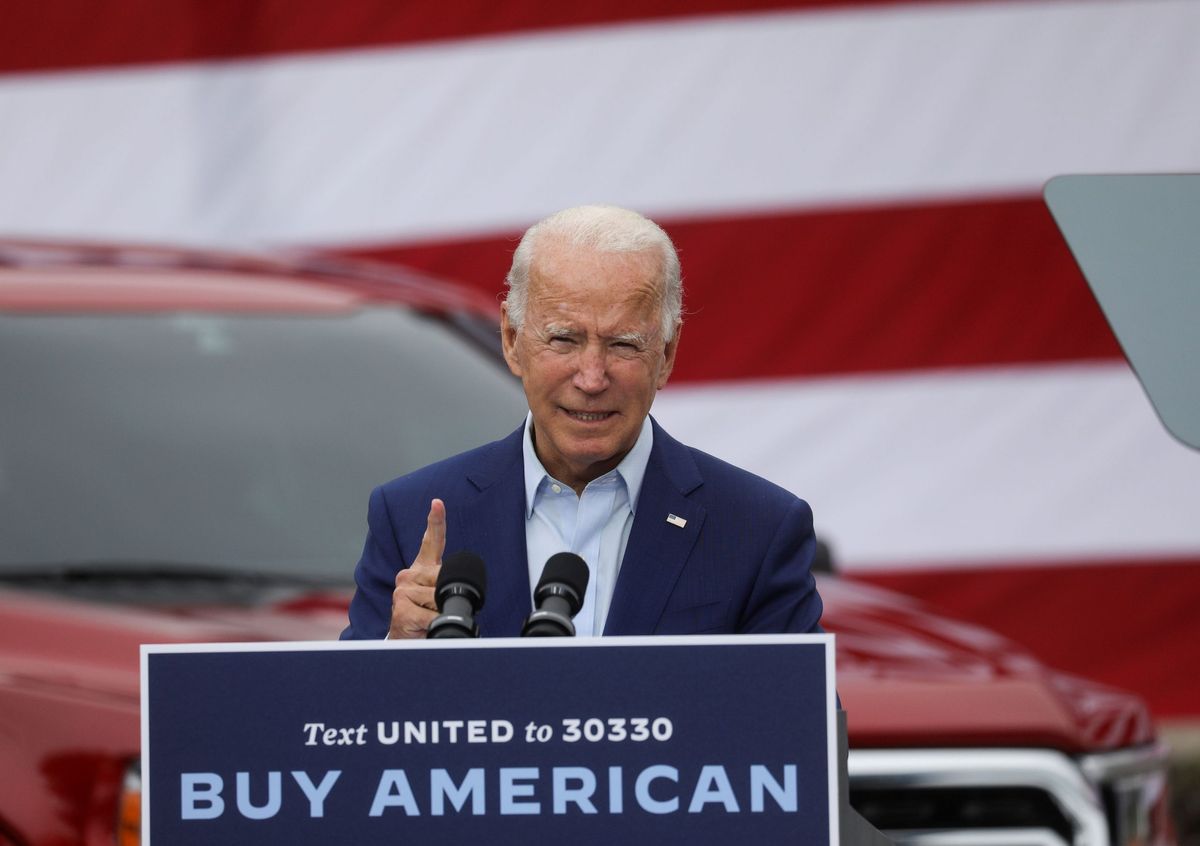Here’s where Donald Trump and Joe Biden stand on the economy

A few minutes every morning is all you need.
Stay up to date on the world's Headlines and Human Stories. It's fun, it's factual, it's fluff-free.
The two economic platforms put forward by former-Vice President Joe Biden and President Donald Trump differ substantially, making the 2020 election one of historic consequences.
The 2020 presidential election is likely to be one of the most consequential in recent times.
Whichever administration is in office after January 20, 2021 will face the daunting task of rebuilding the United States from the economic pitfall it’s suffered as a result of the coronavirus pandemic.
Yet the visions of this recovery, offered by Democratic presidential nominee Joe Biden and President Donald Trump, could not be more different.
A totally changed America is almost certain to come out of the coronavirus pandemic. But the ways in which it has changed will very largely depend on who occupies the White House come January.
The coronavirus recovery
Whether the election in November determines that the president for the next four years will be a Democrat or Republican, the winner faces the unenviable task of rescuing the country from an unprecedented economic fallout and loss of human life as a result of COVID-19.
The US has seen over 200,000 die from the coronavirus, a fifth of the world’s total deaths from the virus, with the global total having recently exceeded 1,000,000. Cases in the US continue to average out at many tens of thousands a day, even as some states have proceeded with controversial reopening plans that will almost certainly see cases continue to circulate.
With the human toll of the pandemic disastrous enough, the next administration must also consider the long-lasting economic effects of the virus, which have already devastated certain sectors of the economy and forced millions out of work.
The US Bureau of Labor Statistics shows that the civilian unemployment rate remains at around 8.4%, having dropped from a high of 14.7% in April, which means that millions of Americans remain out of work. US gross domestic product (GDP) also suffered its worst-ever contraction as a result of the coronavirus pandemic, shrinking at an annual rate of 32.9% in the second quarter of 2020.
On top of this, economists have warned of further economic pain should the US economy receive no further stimulus.
All of which goes without mentioning the profound costs of the rising global crisis of climate change, which will dramatically impact the world – and the US economy – as we know it. Fires that have spread across the West Coast of the US are but a warning sign of further climate change-induced crises to come.
Both candidates present two radically different platforms to address these converging crises.
Biden’s platform
The Democratic challenger, former-Vice President Joe Biden, has received criticism for his past stances on a number of issues, but many progressives agree that his platform for the 2020 election is one of the most progressive among Democratic presidential challengers in recent memory. His economic policies are a core part of this.
In a purely economic sense, Biden’s response to the ongoing COVID-19 pandemic involves increased federal spending to “Build Back Better,” as his campaign slogan puts it.
In July, the Biden camp unveiled plans for his “Buy American” policy, which aims to create five million new American jobs, with the US government spending some US$400 billion on American products and services to grow domestic industries. Another US$300 billion under this policy would be spent on research and development in key industries, such as clean energy, to reestablish the US as a front-runner in these emerging fields.
Biden has also pledged to provide essential workers with a COVID pay boost and has proclaimed his support for raising the federal minimum wage to US$15 dollars an hour. His worker platform also aims to shore up protections and rights for workers in the “gig economy” and make it easier for workers more generally to unionize.
Biden’s campaign has also indicated it will raise federal revenue by US$3.8 trillion over 10 years, with higher taxes for those earning US$400,000 a year or more, including raising the corporate tax to some 28%.
The Biden administration would aim to spend the revenue it raises on infrastructure programs, affordable housing and education, as well as the more general “Build Back Better” economic platform.
Corporate income tax stood at 38% in 2016, before President Trump’s tax cuts in 2017, which saw US tax revenue as a proportion of GDP drop significantly. Biden’s proposed increase in corporate income tax is, if anything, modest.
In the climate emergency, Biden’s platform recognizes opportunity, but only if decisive action is taken. Alongside recommitting to the Paris Climate Agreement, which the Trump administration withdrew from, Biden has proposed a “Clean Energy Revolution” that would invest US$2 trillion and create 10 million jobs.
A Biden administration would incentivize a shift to cleaner energy sources by ending fossil fuel subsidies and aiming to achieve net-zero emissions by 2050.
Commenting on the plan, Biden said that, “when Donald Trump thinks about climate change, the only word he can muster is ‘hoax.’ When I think about climate change, the word I think of is ‘jobs.’”
Biden’s economic plans have already received some notable praise. Analysis by Moody’s Investors Service, the financial research group, has suggested that a Biden presidency would be better for the economy than a continuation of the Trump presidency. Moody’s analysts claimed that Biden’s spending programs would see a quicker recovery from the coronavirus recession and would also create more jobs in the process.
But the massive spending planned by the Biden camp will see an already historic US deficit rise considerably, though this may prove to be the temporary cost for recovery from the coronavirus recession.
Biden’s campaign is also hoping that Biden’s past performance in rescuing the US economy, having overseen the American Recovery and Reinvestment Act in 2009 – will convince voters that he, not Trump, is the man to lift America out of the unprecedented economic hole it has found itself in.
Trump’s policies
A reelected President Trump would largely continue the economic policies he carried out during his first term.
In the 2016 Presidential Election, then-candidate Trump announced that he would reduce the national debt by eliminating waste in federal spending.
The best way to do this, according to President Trump, was for a massive tax cut that he believed would stimulate growth by lowering the tax burden on higher earners who would then funnel funds back into the economy directly.
Rather than eliminating the national debt, President Trump has instead contributed to it significantly. The national debt on January 20, 2017, when Trump was inaugurated as president, stood at US$19.9 trillion.
At the end of eight years, according to Trump’s budget estimates, the US national debt will increase to a record US$28.5 trillion, with US$8.3 trillion expected to be added over the course of his presidency.
This is largely a result of the 2017 Tax Cuts and Jobs Act – one of the few headline pieces of legislation out the Trump administration. The act cut corporate taxes from 35% to 21% and top individual income tax rates were dropped to 37%. Despite the tax cuts and the resulting decrease in federal revenue, military spending allocated in the budget for the 2021 fiscal year stands at US$934 billion – an increase.
Despite the role his administration has already played in increasing the federal debt and the deficit, President Trump has promised to extend these tax cuts should he win reelection, all the while promising budget cuts to a whole host of government programs including Medicaid and Medicare, while corporations and top-earners continue to pay less in tax.
President Trump will also likely continue weakening regulations for banks and lenders, as has been the case throughout his first term. In 2018, the president signed the Economic Growth, Regulatory Relief, and Consumer Protection Act, which eased regulations on banks with assets from US$100 billion to US$250 billion, allowing them to make riskier investments with depositors’ funds.
Some critics have claimed that the weakening of these regulations has made another banking crisis, akin to the 2008 financial crisis, more likely.
On the climate, President Trump has not envisioned an opportunity for more jobs like Biden has, but instead is likely to continue to neglect investment in alternative energy sources and continue to permit expanded drilling operations and fossil fuel usage.
Throughout his presidency, President Trump has been averse to allocating funds to combat climate change or incentivize a shift toward greener energy sources. In June 2017, the administration announced its withdrawal from the Paris Climate Agreement and in August 2018 it allowed automakers to maintain low fuel efficiency standards, allowing cars to have less fuel economy and thus more oil to be consumed.
President Trump has also opened more areas in the US for the drilling of oil and recently made plans to push forward with drilling in the vast wilderness and wildlife area of the Arctic Refuge.
Though his overall polling numbers should be worrying for the incumbent president, he’s certain to find polls on his handling of the economy happier reading.
A New York Times / Siena College poll recently found that, although 55% of voters said President Trump was somewhat or mainly responsible for the economic downturn in the wake of the coronavirus pandemic, 54% of voters still approved of his handling of the economy.
Though the favorable numbers for President Trump’s handling of the economy in polls remain somewhat strong, they have not been enough to win over significant numbers of new voters, especially those identifying as Democrats, who still overwhelmingly disapprove of the president’s handling of the economy.
The image of the successful businessman that Trump has cultivated to present himself as the best guardian of the US economy, especially in times of crisis, may also be impacted by recent reports showing his businesses’ huge losses and the little to no income tax the president has paid in recent decades.
The two economic platforms put forward by former-Vice President Joe Biden and President Donald Trump differ substantially, making the 2020 election one of historic consequences.
Whichever man prevails, the US faces a steep road toward economic recovery with both candidates plotting radically divergent paths toward getting there.
Have a tip or story? Get in touch with our reporters at tips@themilsource.com




Comments ()